The development of warship design has been largely influenced since the introduction of gunpowder by continuous alterations in the size, number and type of the naval weapons
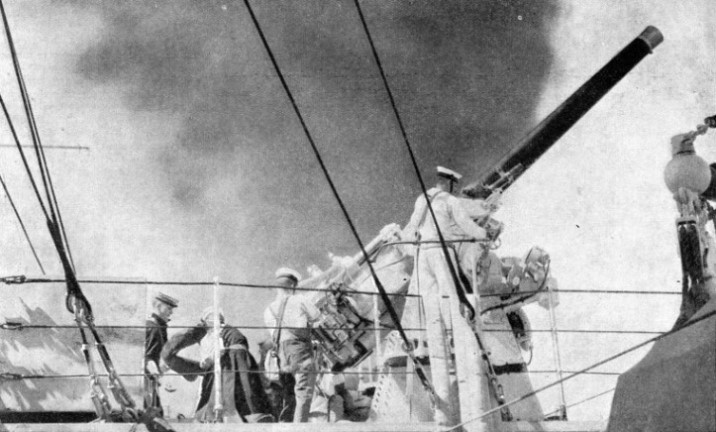
GUN DRILL IN A MODERN WARSHIP. A cruiser of 9,870 tons displacement, H.M.A.S. Australia is armed with eight 8-in. guns, four 4-in. anti-aircraft guns, twenty-six smaller pieces and eight torpedo tubes. Submarine and aerial warfare have considerably complicated problems involved in the design and the armament of the modern warship.
ALTHOUGH the early guns carried by sailing ships were crude pieces of ordnance, they were effective in their day. They enabled a handful of sea adventurers to secure coastal strips which served as bases from which vast territories were conquered. The guns overawed the hordes of natives on the coast, and enabled the Europeans to keep open their sea-lines of communication. For a long time after the invention of gunpowder the longbow and the crossbow remained formidable hand-weapons, but the cannon soon became the supreme weapon for discharging heavy missiles from ships.
Soon after its introduction the gun brought problems which caused the evolution of a special class of ship for war. Warships became tiers of guns. In recent years the supremacy of the gun has been questioned, but the great navies continue to rely upon the capital ship, with her mighty guns, as the most powerful arm of the fleet. The evolution of the torpedo, which can be discharged
from a surface vessel, a submarine, an aircraft, or from the shore, is one factor that has altered the gun’s supremacy. Another is the aircraft, which can operate from land, from the surface of the sea or from the deck of an aircraft carrier. Aircraft can drop bombs or depth charges, act as scouts, observe for the gunnery officers of warships, or lay smoke-screens to protect ships from enemy observation. Together the submarine and the aircraft have so complicated the problem of ship and gun that experts are divided into conflicting schools of thought and there is no clear solution that will answer for all the difficulties involved.
Although the naval architects of old were spared the modern complications of air and under-water problems their own puzzles were difficult to solve, and they were continually experimenting. They had almost continuous opportunity of checking theory by practice from the time when guns were first used in ships to the close of the Napoleonic -wars in 1815.
After a lull of a few decades the introduction of steam, the rifling of cannon, improvements in the propelling charges and in the missiles, the change from wood to iron and then to steel, and the consequent increase of the range of fire ushered in a new era. The Crimean War (1854-6), the American Civil War (1861-5) and the Russo-Japanese War (1904-5) in turn influenced naval architecture, and the war of 1914-18 left problems that have yet to be solved.
The first cannon were mounted on the upper works of the vessel, on the aftercastle and the forecastle, and then in the waist. As cannon became larger and heavier and more of them were required, it was necessary to bring the weight lower to avoid impairing the stability of the ship. After some hesitation about the wisdom of weakening a ship by cutting holes in her hull, gun-ports were devised, and the guns were brought lower into the ship and crammed into every available space along the sides of the man-of-war. Although it made the ship a formidable fortress, the cannon brought weakness, as well as strength, and exposed the ship to explosion during action. In a battle between English and French ships off Brest in 1512, the Regent, the biggest ship in the English fleet, blew up with 700 soldiers, sailors and gunners. The French Admiral Primauget’s ship, with 900 men, was also destroyed. Henry VIII replaced the Regent by the famous Henri Grace a Dieu, built in 1514. Into this ship no fewer than 186 guns were placed. Of these 122 were breech-loading iron serpentines, four were muzzle-loading brass serpentines and the remainder were breech- and muzzle-loaders of varying bores and types. When the warship was rebuilt in 1540 the number of guns was reduced to 122.
Uncertain in aim and behaviour, the early guns required considerable courage on the part of the gunners, who were sometimes killed by the bursting of their pieces. Accidents were due to a weakness in the gun, to a mistake in the mixing of the ingredients of the gunpowder or to an experiment on the part of the gunner in increasing the charge.
Early guns were made of iron or bronze bars welded longitudinally and strengthened by iron hoops. The cannon balls were of stone and, later, of iron. The breech-loaders embodied the rough principle of the modern breech-loading gun. The breech was in the form of a trough. The charge of gunpowder was placed in the chamber, a receptacle resembling a jug, and this was put into the trough and wedged and lashed firmly in place. When the gun was fired the gun crew got as far away as possible; the gunner ignited the charge by means of a torch and then jumped out of the way. This arrangement was so hazardous to the gunners that they welcomed the brass muzzle-loader, a much safer gun for the men behind the muzzle. This type threw a ball farther than the iron gun and blew up more rarely. The brass gun lasted for centuries after cast-iron guns were evolved. A block of brass was cast and then bored. The brass culverin became the long-range ordnance of its day and weighed about 2 tons, although it threw only an 18-lb. shot.
Makers of ordnance were concerned with the problem of range and weight of missile, and evolved types to suit every purpose. The cannon-royal of the early days had a bore of 8 to 8½ in. and threw a 64-lb. or 68-lb. ball, but not for a great distance.
At one time light guns were mounted in primitive fighting tops on the masts, but they often set fire to the rigging and sails, and this idea was virtually abandoned. The range of the lighter guns was increased by a fork, which supported the muzzle and could be raised or lowered, but this device was too weak for the heavy guns. The gunners of these had to wait until the ship was brought within range of the enemy, after which the damage was terrible, for the percentage of hits at such close quarters was far greater than in the long-range actions of modern times.
It was not then a question of visibility, scientific range-finders, armour, signalling and shell fuses, but one of primitive gun-drill and human strength and courage.
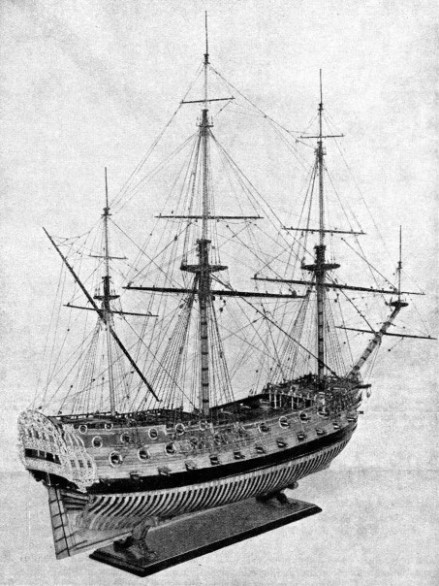 The French were better naval architects than the British, but the British proved the better gunners, the British rate of fire being much faster than that of the French. Excellence in gun-serving and seamanlike ability gave the British an advantage when they were opposed to the French or the Spanish, but in the British actions against the Dutch and the Americans, born seafarers, victory was not so easily won.
The French were better naval architects than the British, but the British proved the better gunners, the British rate of fire being much faster than that of the French. Excellence in gun-serving and seamanlike ability gave the British an advantage when they were opposed to the French or the Spanish, but in the British actions against the Dutch and the Americans, born seafarers, victory was not so easily won.
MODEL OF A 70-GUN SHIP built towards the close of the seventeenth century. Twenty-four 24-pdrs. were situated on the lower gun-deck, twenty-four 12-pdrs. on the upper gun-deck, fourteen 6-pdrs. on the quarter-deck, four 6-pdrs. on the forecastle and four 3-pdrs. on the poop. The model resembles the Essex, which was of 1,090 tons burden. Her gun deck was 150 ft. 4 in. Long.
As time went on, warships were rated by the number of guns they carried. In Nelson’s day the present capital ship was represented by the first-rate ship of 100 or more guns, carrying about 950 men. The tonnage was about 2,600 and the cost as much as £100,000 without guns. The second-rate ship carried from 90 to 98 guns and 750 men, was a 2,000-tonner and cost £60,000. A third-rate ship carried from 64 to 80 guns and 720 to 490 men. Her tonnage was between 1,300 and 2,000 and she cost from £36,000 to £54,000. Nelson thought much of the 74-gun ships of this rate, which were the battle cruisers of their time.
Fourth-raters carried 50 guns and 350 men; they were 1,100 tonners and cost £26,000. The number of guns in a fifth-rater ranged from 32 to 44, her complement from 215 to 320 men, her tonnage from 700 to 900 and her cost from £15,000 to £21,500. The sixth-raters carried from 20 to 28 guns, 160 to 200 men, were under 650 tons and cost up to £13,000 Such were the wooden walls of England.
Carronades, so called because they were first cast at Carron, in Scotland, were light, short guns mounted on the quarter-deck and spar-deck. They came into use in 1779, and were extremely formidable at short ranges, firing balls of from 6 to 12 lb., but they were useless at long ranges. The 32-pounder cannon could be elevated to send a shot over a mile, but the carronade had only about half this range.
At close quarters the shot from the carronade created havoc by smashing the side of the enemy ship and sending the splinters flying, and the splinters spread with the force of shrapnel. Case or canister shot was used at close quarters.
This shot consisted of a tin case packed with bullets or half-pound balls. Grape-shot consisted of two-pound shot packed in canvas bags which fitted the bore of the gun. “Langridge” consisted of scraps of metal fastened together, and varieties of chain and bar shot were fired to rip sails, to smash masts and spars and to kill men.
The cannon was mounted on a substantial wooden carriage with wooden wheels. The trunnions, two sidepieces which supported the barrel, were slightly forward of the point of balance, so that the breech was lower than the muzzle when the gun rested on the carriage. A heavy wedge
was used to keep the barrel horizontal, and by moving the wedge the muzzle could be elevated or depressed.
The gun was lashed in position by ropes, and at all times the care of these lashings, which prevented the gun from sliding from one side of the ship to the other, was imperative. Sometimes in storm a gun broke adrift and two or three tons of metal and wood became a battering ram which had to be tamed by thrusting hammocks and sails before and behind it, or by overturning it and lashing the monster securely.
Terrific Recoil
To load the gun, the “cartridge” was thrust down the muzzle into the breech by a copper ladle with a long wooden handle. A wad of yarn was rammed home on the cartridge. If the shot was red-hot, the wad was of damp wood and yarn. The shot was rammed home, and after this another wad to keep the ball in place. The gun was not mounted on deck, but was hauled forward so that the muzzle projected from the gun-port.
To fire the gun, the gun captain first thrust a priming iron through the touch-hole to pierce the cartridge. Next he primed the gun, either by pouring powder down the touch-hole and along the groove cut in the gun, or by inserting a tin or quill priming tube filled with powder into the touch-hole. He took the slow-match, a length of smouldering cotton wick, applied the red-hot end to the priming, and drew back smartly to avoid the spit of flame from the touch-hole as the gun went off.
Flint-locks were fitted to guns to fire the priming, but lighted slow-matches were carried lest the flints should misfire. Directly the gun fired, its crew had to look out for the recoil. Nobody knew which way it would come back, and, although the recoil was checked by the breeching (the ropes which secured the breech of the gun to ring-bolts in the ship’s side), this sometimes burst, and a gun heated up by continuous firing had a trick of jumping up, with its carriage, and hitting the deck beams above. If the breeching held, the gun recoiled to the loading position with the muzzle just inside the port, and smouldering fragments of the cartridge could be scraped out and the bore sponged and cleaned before the next cartridge was rammed home. Buckets of water were used to cool the guns, but in a long action the guns became so hot that the charges were reduced.
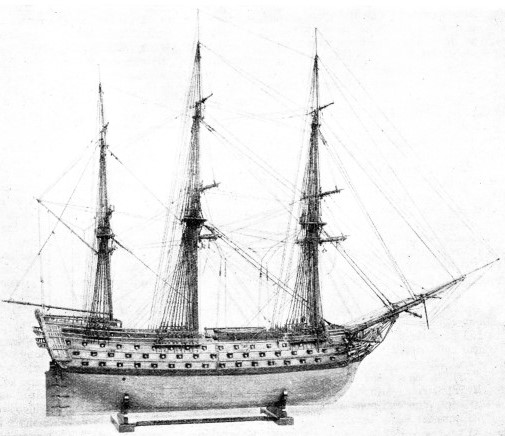
REPRESENTING A FRENCH FIRST-RATE OF 120 GUNS, built in the last decade of the eighteenth century. The original had a burden of 2,503 tons, with a length of 156 feet on the keel and a beam of 51 ft. 9 in.
The heaviest guns were mounted on the gun deck, which was below the upper deck, and was the roomiest and strongest deck of the ship. The warship was a floating prison for the seaman, and many of the men who gave Great Britain her naval supremacy were kidnapped by the press-gangs, were defaulting debtors, or were criminals who had been forced to choose between jail and the Navy. Many deserted at the first opportunity, and some of these deserters helped to man the American ships which fought the British in the war of 1812. The period was one of dogged fighting relieved by some instances of chivalry.
During the battle of the Nile, 1798, the French Orient caught fire and blew up with such a dreadful explosion that the horror of it stopped the action on either side for ten whole minutes. Nelson, who had been badly wounded in the head, appeared on the quarterdeck of H.M.S. Vanguard and gave orders to send boats to the relief of the enemy, many French being saved by boats or being dragged into the lower gunports of British ships by sailors.
At Trafalgar Nelson had 2,048 guns against Villeneuve’s 2,626. The three largest British ships, the Victory, the Royal Sovereign and the Britannia, each carried 100 guns. In the opposing fleets of France and Spain the Santisima Trinidad had 130 guns, the Principe de Asturias and the Santa Ana 112 guns, and the Rayo 100 guns. Although Nelson had fewer ships, guns and men, his men served the guns far faster than did the enemy.
Nelson followed his usual tactics of closing the range to get the full advantage of this faster rate of fire. This caused his death, as he was mortally wounded by a bullet fired from the mizen-top of a French ship.
So terrific was the effect of a line-of-battle ship’s broadside that naval commanders did not hesitate to attack powerful forts. Admiral Lord Exmouth, with a combined British and Dutch fleet, bombarded Algiers, then a nest of pirates, in 1816. Defying the fire of nearly 500 guns from the batteries, he forced the enemy to surrender. The ships fired 118 tons of powder, 50,000 shot and 960 13-in. and 10-in. shells.
Ironclads and Turret Ships
The first steam warship was designed by Robert Fulton in 1813 to break the British blockade of the American coast. Called the Fulton the First, she was launched in 1814. Her armament consisted of twenty 32-pounders, and her paddle wheel was placed in a channel between twin hulls, out of the way of enemy fire. The vessel blew up accidentally in 1829, and was never tried in action.
The British Admiralty looked askance at the steam warship, as well it might, for the early craft were strange contraptions, and their vulnerable paddle wheels and inefficient engines did not impress men who had fought under Nelson. But four steam warships, the biggest of which was the teak paddle frigate Gorgon, 1,111 tons, armed with four 32-pounders and two 10-in. guns, took part in the bombardment of Acre in 1840. Iron paddle frigates were built, and these were in service during the Crimean War, especially during the bombardment of Sevastopol, but nearly always as tugs for towing the sailing ships into and out of action.
The screw propeller enabled line-of-battle ships to be fitted with auxiliary screws for use in calms, and screw frigates and battleships mounted respectable armaments and could steam at 10 knots. Such ships took part in the operations in the Baltic during the war with Russia. Because of the increasing power of the gun and the shell, this war brought out the fact that warships needed protection.
The French armoured wooden floating batteries with iron plates, and three of them closed to within 1,000 yards of Russian batteries and bombarded them without being damaged. The French sent the plans to the British, who built three ironclad floating batteries which were completed after the cessation of hostilities. Then the French built an iron-armoured wooden frigate, the Gloire, and the British followed with H.M.S. Warrior.
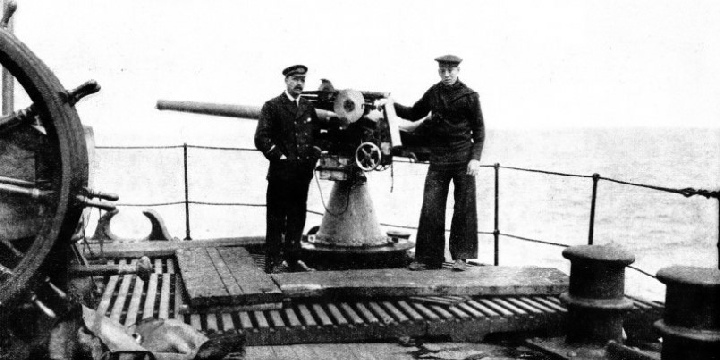
A MERCHANT SHIP ARMED for defence against submarine attack during the war of 1914-18. As far as was possible a gun was mounted in every merchant vessel during the war. The Collegian, a vessel of 7,237 tons gross, was armed with a gun on her port quarter. Built at Glasgow in 1899, the Collegian had a length of 470 feet, a beam of 56 ft. 2 in. and a depth of 31 ft. 10 in.
The Warrior and her sister, the Black Prince, marked a radical change in design and armament. Originally they were armed with breech-loading rifled guns, and these were afterwards replaced with muzzle-loaders, the heaviest of which were 8-in. 9-ton guns. The old fashion of mounting guns in tiers was dropped, and the main guns were mounted on one deck. Both ships were at first designed to carry 68-pounder smooth-bore guns, but these were superseded by the new breech-loading rifled gun. The breech-loaders were replaced with rifled muzzle-loaders, because muzzle-loaders were considered more reliable.
Ericsson’s Monitor and her duel with the Merrimac again altered designs, and were responsible for the introduction of the turret ship. This action had world-wide importance, as it was the first between armoured warships, and the Monitor embodied the idea of the revolving turret. This idea was not new in conception — it had been put forward years before — but the Monitor was the first turret ship.
The Confederates raised the Federal frigate Merrimac, rebuilt her as an ironclad and renamed her the Virginia. They armed her with two 7-in. and two 6-in. rifled guns, and with six smoothbore 9-in. guns, and fitted a formidable ram. She made havoc of the Federal frigates, and the Federals looked to the Monitor to rid them of the ship they feared.
The Monitor was small and carried a crew of about sixty, against the 300 of the Merrimac, and only two 11-in. guns. The fight took place in Hampton Roads in 1862, after the Merrimac had set fire to one vessel and sunk another. She received some damage, but no one was killed in the action, although some were wounded. Neither ship was sunk. The draught of the Monitor was only 10 ft. 6 in., and with her low freeboard she was not suitable for the high seas.
The turret was adopted for various types of ships. For some time the fixed battery ship was in vogue, but a combination of the two was evolved by which the top and sides turned, but not the base.
Iron ships and muzzle-loading guns gave place to steel ships and breech-loaders, the first large British ship to be so built and equipped being H.M.S. Conqueror, 1881.
A New Standard
The change from ships mounting a large number of guns to ships carrying few guns which could be fired rapidly was demonstrated by the bombardment of Alexandria by a British fleet in 1882. The fleet mounted only 102 guns, two more than the total of Nelson’s Victory, but the eight ironclads smashed the forts.
Guns grew in size until the 16¼-in. 111-tons gun was reached, but this proved a failure and the 12-in. gun was the standard “heavy” at the end of the last century, and persisted until 1910. Then the 13.5-in. and, later, the 15-in. guns were placed in new ships. Meanwhile, the development first of the torpedo-boat and then of the torpedo-boat destroyer had compelled attention to improvements of the secondary or lighter armament of big ships. The torpedo-boat proved unsuitable for sea work in rough weather, and gave way to the bigger and faster destroyer, against which the battleship was armed with quick-firing guns of 6 in. and less.
H.M.S. Dreadnought, launched in 1906, revolutionized the gun and ship theories. She embodied the ideas which the late Lord Fisher had evolved from the lessons of the Russo-Japanese War. She carried ten 12-in. guns, in pairs, in five hooded barbettes, and twenty-four 12-lb. quick-firers. She steamed at 21.2 knots and displaced 17,900 tons. Four 12-in. guns were the most that any earlier battleship had carried, and the Dreadnought's guns, armour and speed set the standard for a race in armaments. She was soon outclassed, and the size of guns went up to the 15-in., the heaviest gun to be carried by battleships in the war of 1914-18, and the 16-in., mounted by the big ships of to-day. H.M.S. Queen Elizabeth, with eight 15-in. guns, 31,100 tons displacement and 25 knots speed, represents the war-time development the Dreadnought. From this class has evolved the still larger giant battleship.
Despite science, the combination of the ship and the gun is to-day as great a gamble as it was before the last war. Every expert has theories; no man is sure.
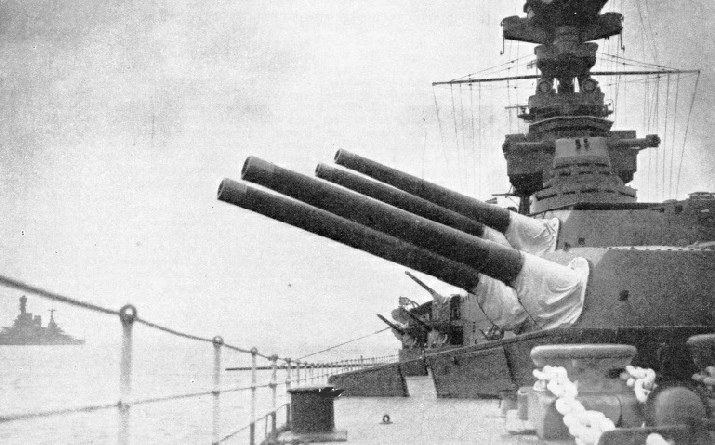
15-IN. AND 5.5-IN. GUNS constitute the main armament of H.M.S. Hood, a battle cruiser of 42,100 tons displacement. The Hood has eight 15-in. and twelve 5.5-in. guns. Her armament includes, in addition, four 4-in. anti-aircraft guns, twenty-three smaller guns and six torpedo tubes.
You can read more on “At Sea in the Middle Ages”, “Battleships and Cruisers” and “Early Steam Warships” on this website.




 The French were better naval architects than the British, but the British proved the better gunners, the British rate of fire being much faster than that of the French. Excellence in gun-
The French were better naval architects than the British, but the British proved the better gunners, the British rate of fire being much faster than that of the French. Excellence in gun-

